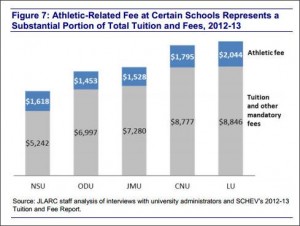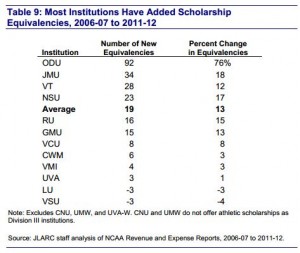by James A. Bacon
Of the 269 sports programs at Virginia’s 15 public colleges and universities, only four pay their own way — the Virginia Tech and the University of Virginia football and basketball programs. The rest lose money and are subsidized by mandatory student fees equivalent to 12% of tuition and fees in 2011-2012, according to a blockbuster report just published by the Joint Legislative Audit and Review Commission (JLARC).
Virginia students collectively paid $160 million in athletic fees that year — 49% more than in 2006-2007. Athletic fees vary widely from institution. They are smallest at Virginia Tech, only $267 per student, which has profitable football and basketball programs and a large student body across which to spread the costs, but they are stunningly high at smaller institutions. Longwood University students effectively paid $2,044 in 2012-13, and Christopher Newport University paid $1,795.
At Norfolk State University mandatory athletic-related fees amounted to a colossal 24% of in-state tuition and fees in 2012-2013. With those priorities and what the Virginian-Pilot calls “significant accreditation issues,” is anyone surprised that the NSU board of visitors recently fired President Tony Atwater?
Even while crying crocodile tears over tight-fisted state support for higher education, many state institutions have been steering resources into money-losing athletic programs. States JLARC:
Virginia athletic programs tend to spend more than other schools in comparable NCAA divisions and have increased their spending faster than other programs across the country. Most of the athletic spending in Virginia can be attributed to growth in scholarships, coaching and support salaries, and facilities.
Scholarships: Virginia institutions spent $22 million more on athletic student aid in 2011-12 than six years earlier. (General student aid declined during that period.) Higher tuition accounts for only part of that increase. Universities also have been handing out more athletic scholarships. Old Dominion University led the way, with James Madison University, Virginia Tech and NSU handing out an above-average number of full-scholarship equivalencies.
Coaching staff: The public colleges have been loading up on coaching staff and boosting salaries. Virginia Commonwealth University more than doubled its average salary for men’s head coaches. (Men’s basketball coach Shaka Smart probably had a lot to do with that.) Statewide, growth for coaches’ salaries ran 31% between 2006-07 and 2011-2012.
Facilities: Virginia institutions have spent $342 million on capital projects related to athletics in the last six years. New facilities not only run up debt service costs but incur ongoing obligations for buildings & grounds maintenance, utilities, rental fees and equipment maintenance.
Much of this spending is driven by the quest for status associated with participation in NCAA’s Division I, JLARC notes. Switching divisions comes with major costs such as an increase in the number of scholarships offered and the number of sports the institution is required to field.
A case in point is Longwood University, which made the move to Division I in 2007-2008 to “increase visibility and enhance the institutional image.” Between 2000-2001 and 2009-2010 athletic expenditures at LU more than tripled, to $6.8 million. Because Longwood athletic programs generated only 10% of their own revenue, the balance came from student fees– which also tripled, to $2,009 per student.
Likewise, the introduction of football programs is expensive. The sport is a crowd pleaser but it runs up costs. Seven years after introducing football in 2005, ODU had tripled its athletic expenditures to $34.4 million.
Ironically, while students shoulder much of the cost burden, their level of interest isn’t always high. Average attendance at George Mason University basketball games runs about 2% of the student body. In JLARC-led focus groups of students at all 15 institutions, a majority of students said that a successful athletic program was “not important” to their decision to attend and “not important” to their college experience. More than two-thirds said they would be willing to scale back athletics if it meant a reduction in the price to attend college.
Kudos to JLARC! Chapter 2 of the study is one of the hardest-hitting state research reports I have ever seen. JLARC staff deserve special credit: Justin Brown, division chief; Walt Smiley, project leader; and Lauren Axselle, Drew Dickinson, Laura Parker and Greg Rest. Let’s see more kick-butt work like this!!





